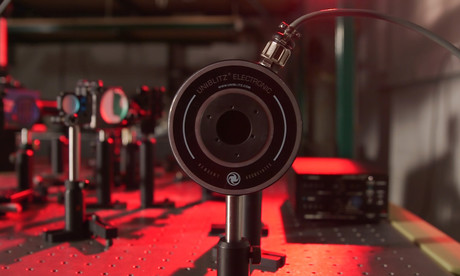Imaging microstructures at the speed of light

Over the last few years, researchers at the University of Rochester have altered materials to make them repel water, attract water and absorb great amounts of light — all through the use of irradiated laser pulses.
Now, the team has developed a technique to visualise the complete evolution of micro- and nanoscale structural formation on a material’s surface, both during and after the application of a laser pulse. Their research has been published in the journal Light: Science & Applications.
Creating and altering the micro- and nanostructures in materials makes properties intrinsically part of the material and reduces the need for temporary chemical coatings. The researchers achieved this through the use of a femtosecond laser, which produces an ultrafast pulse with a duration of tens of femtoseconds (a femtosecond is equal to one quadrillionth of a second). Changing the laser’s conditions caused changes in the morphological features of the surface structures — such as their geometry, size and density — leading material to exhibit various specific physical properties.
“After we determined that we could drastically alter the property of a material through creating tiny structures in its surface, the next natural step was to understand how these tiny structures were formed,” said Chunlei Guo, the leader of the research team.
“This is very important because after you understand how they’re formed you can better control them,” Guo continued. This control could open the way for improvements in all kinds of technologies, including anti-corrosive building materials, energy absorbers, fuel cells, space telescopes, airplane de-icing, medical instrumentation and sanitation in third-world countries.
But it is difficult to obtain detailed images and movies of events in micro- and nanoscales because they occur during a matter of femtoseconds, picoseconds (one trillionth of a second) and nanoseconds (one billionth of a second). For Guo and his team, the solution lay in a technique involving scattered light.
During a femtosecond laser pulse, the beam is split in two. One pump beam is aimed at the material target, in order to cause micro- and nanostructural change, and the second probe beam acts as a flashbulb to illuminate the process and record it into a CCD camera — a highly sensitive imaging device with high-resolution capabilities.
“With the scattered light pulsing at femtosecond time intervals, we can capture the very small changes at an extremely fast speed,” said Guo. “From these images we can clearly see how the structures start to form.”
The technique opens a window on the entire process, from the moment a laser hits the material to melting, transient surface fluctuations and resolidification resulting in permanent micro- and nanostructures. In addition, Guo noted that the technique has applications for capturing any process that takes place on a minute scale.
“The technique we developed is not necessarily limited to just studying the surface effects produced in my lab,” said Guo. “The foundation we laid in this work is very important for studying ultrafast and tiny changes on a material surface.” This includes studying melting, crystallography, fluid dynamics and even cell activities, he said.
Best practices for safe centrifugation in the laboratory
The majority of all centrifuge accidents are understood to result from user error. These tips...
Nature-inspired filtration system recovers critical resources
A filtration system that can recover untapped critical resources such as copper and lithium from...
Optimising food and beverage testing with laboratory equipment
In the food and beverage industry, laboratories must balance precision, speed and compliance to...





